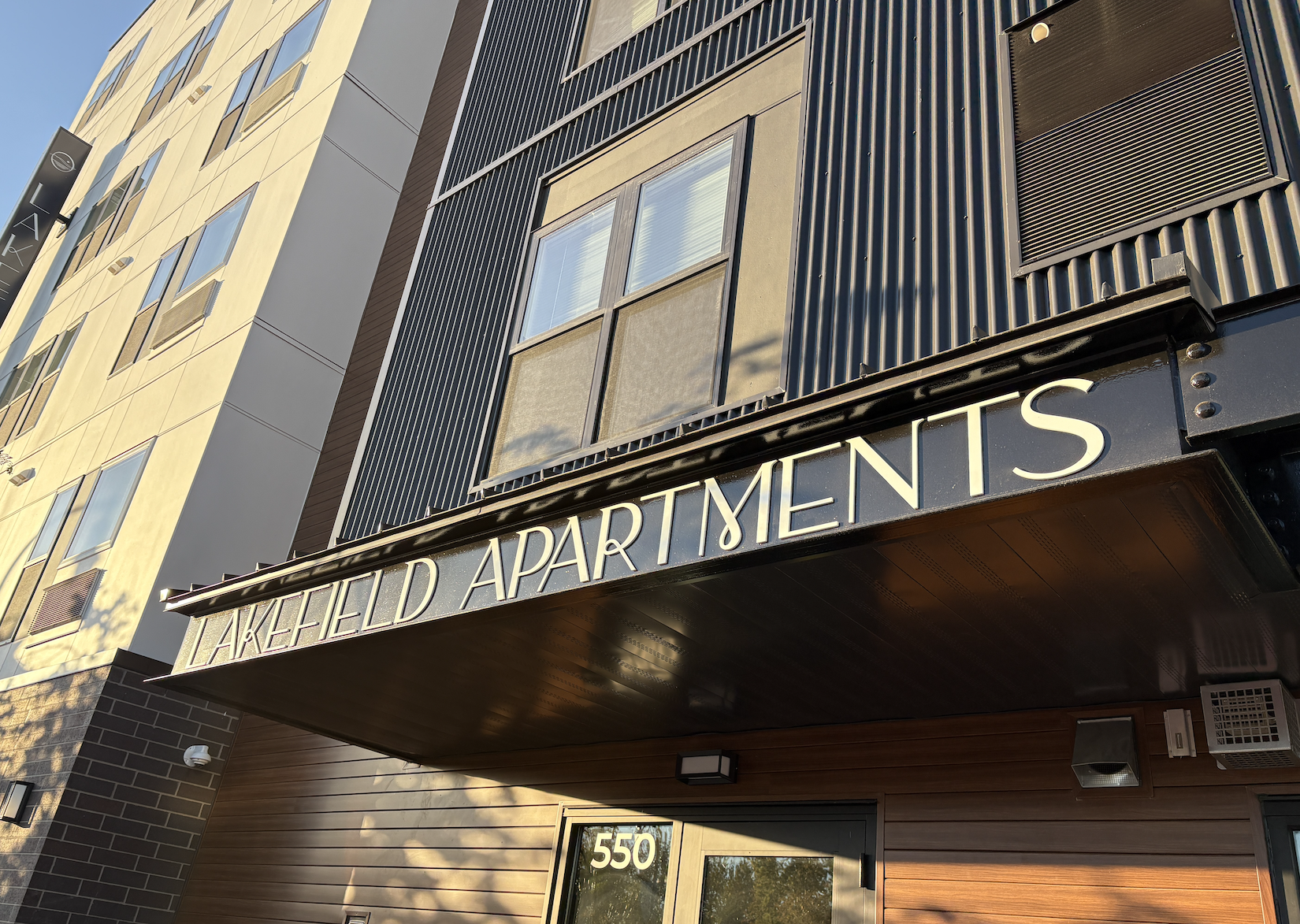The third and final building in Lupe Development Partners’ LynLake apartment campus is open and mostly leased, marking one of the few large multifamily housing projects to come online anywhere in Minneapolis this year.
In the works since 2020, Lakefield Apartments has 110 units in two-, three- and four-bedroom configurations. It’s helping to shrink the shortage of apartments spacious enough for larger and families in this sought-after part of town near the Midtown Greenway and B Line bus rapid transit line, says Aaron Diederich, vice president at Lupe.
“The feedback and market indicators we saw told us that there was a shortage of these family-style units in the affordable space,” Diederich says.
Seeing that gap, Lupe added another parcel to the Lakefield project and boosted the unit count by 15 units to accommodate more intergenerational homes. It’s a marked change from Lake Street Dwelling, the first phase of the campus that has “more traditional studios and two-bedrooms,” and an evolution from The Lago, the “more middle-market” second phase, Diederich says.
The high share of three- and four-bedroom units and emphasis on family living requested some design deviations from typical Lupe builds. Kids are louder, so the walls are thicker and the units have sold-core doors. They’re harder on finishes, so the flooring is a mix of luxury final plank, luxury vinyl tile and a type of soft, carpet-like textile that’s moppable.
Those kid-resistant design elements, plus the unavoidable spatial realities of three- and four-bedroom units, did complicate the project’s economics a bit, Diederich says.
“If you’re building smaller units per building, you can put more in at a cheaper per-unit cost…here, you get fewer units with the same fixed costs,” he says.
But Lupe’s choice to focus on families paid off. Diederich says he was impressed by how quickly Lakefield’s larger units leased up. The building was at least 70% leased as of late September and should be fully leased up in a matter of weeks. The model is working so well right now, Diederich adds, that Lupe is going heavy on larger units in the 95-unit Snelling Yards project it’s building near the METRO Blue Line 46th Street Station.
Lakefield counts as a rare housing win for Southwest Minneapolis amid a confluence of factors holding back multifamily development in the area and across the wider Twin Cities metro.
In 2024, the city of Minneapolis greenlighted zero multifamily projects larger than 20 units. That marked a sharp pullback from years earlier this decade, when Minneapolis led the Twin Cities in multifamily permits. Smaller and midsize projects have held up better, but volumes at all size points declined significantly in 2023 and 2024, while applications for projects larger than 150 units “ceased entirely,” the city said in a report earlier this year.
The report cited a litany of barriers to housing development, including high construction costs and supply chain challenges, exclusionary zoning practices that make it difficult or more expensive to build in high-need areas, and financial challenges tied not only to high interest rates but to escalating insurance costs and the overall complexity of piecing together the “capital stack” for affordable housing projects.
“Our projects cost more per unit than market-rate projects, which to me is insane, because of all the different requirements pushed on us,” says Victoria Yepez, principal at VY Enterprise.
Yepez’s boutique development firm specializes in affordable communities with deeply affordable and supportive housing components. It’s nearing financial close on The LOMA, an affordable senior community on the 3200 block of Nicollet Avenue, and hopes to break ground early next year.
Sharp changes in federal policy under President Trump are a mixed bag for housing development in general and affordable housing in particular, Yepez says, adding that the real estate tax provisions in the Republican budget bill that became law in July could counter a decline in equity-focused funding from Executive Branch agencies. Private companies like U.S. Bank have upped their affordable housing investments lately, she adds.
For its part, the city of Minneapolis can do more to support affordable housing development, Diederich says. Lupe Development’s Lakefield announcement hailed the City and the Whittier neighborhood as key partners in the entire three-phase project, but Diederich warns that the lingering possibility the City Council will enact a rent control ordinance has lenders for both affordable and market-rate developers cautious on doing business in town.
Despite the headwinds at the federal and local level, 2024 may prove in hindsight to be a low point for housing development in Southwest Minneapolis. The City says 1,745 affordable units “will have been” funded and closed in 2025, including 234 designated for residents experiencing homelessness — a significant jump from the previous year.
That’s a hopeful sign for the Ward 8 and Ward 10 communities where demand for affordable and supportive housing continues to exceed supply, Yepez says. While the road ahead will likely be more challenging for emerging developers like her, she says the need is too important to ignore.
“It’s important work and we’re committed to doing it,” she says. “Somebody has to.”

.jpg)





